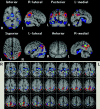Automated discrimination between very early Alzheimer disease and controls using an easy Z-score imaging system for multicenter brain perfusion single-photon emission tomography
- PMID: 17416830
- PMCID: PMC7977345
Automated discrimination between very early Alzheimer disease and controls using an easy Z-score imaging system for multicenter brain perfusion single-photon emission tomography
Abstract
Background and purpose: In Alzheimer disease (AD), a peculiar regional cerebral blood flow (rCBF) abnormality has been reported in the posterior cingulate gyri and precunei, even at a very early stage. We performed a multicenter brain perfusion single-photon emission tomography (SPECT) study to evaluate the discrimination ability of an easy Z-score imaging system (eZIS) with a common normal data base between patients with very early AD at the stage of mild cognitive impairment and age-matched healthy controls.
Materials and methods: For a multicenter study, SPECT images of 40 patients with AD and 40 healthy volunteers were acquired from 4 gamma camera systems in 4 different institutions. Systematic differences of SPECT images between gamma cameras were corrected by using conversion maps calculated from the SPECT images of the same brain phantom. Receiver operating characteristic (ROC) analysis was performed to discriminate patients and controls by using a Z-score in the volume of interest (VOI), which had been defined as a region related to AD in subjects other than those in a multicenter study.
Results: Bilateral posterior cingulate gyri, precunei, and parietal cortices were defined as a VOI showing rCBF reduction in very early AD. A new indicator of rCBF abnormality in the VOI provided 86% accuracy for distinction of AD and healthy controls in the multicenter study. The area under the ROC curve was 0.934.
Conclusion: Because an eZIS can use a common normal data base by converting site-specific SPECT data to the core data, the eZIS was useful for automated diagnosis of very early AD in routine studies in multiple institutions.
Figures



Similar articles
-
An easy Z-score imaging system for discrimination between very early Alzheimer's disease and controls using brain perfusion SPECT in a multicentre study.Nucl Med Commun. 2007 Mar;28(3):199-205. doi: 10.1097/MNM.0b013e328013eb8b. Nucl Med Commun. 2007. PMID: 17264779
-
Superiority of 3-dimensional stereotactic surface projection analysis over visual inspection in discrimination of patients with very early Alzheimer's disease from controls using brain perfusion SPECT.J Nucl Med. 2004 Sep;45(9):1450-7. J Nucl Med. 2004. PMID: 15347711 Clinical Trial.
-
Differentiation of early-stage Alzheimer's disease from other types of dementia using brain perfusion single photon emission computed tomography with easy Z-score imaging system analysis.Dement Geriatr Cogn Disord. 2008;26(6):547-55. doi: 10.1159/000180280. Epub 2008 Dec 10. Dement Geriatr Cogn Disord. 2008. PMID: 19066428
-
[Neurological diseases and SPECT--analysis using easy Z-score imaging system (eZIS)].Brain Nerve. 2007 May;59(5):487-93. Brain Nerve. 2007. PMID: 17533974 Review. Japanese.
-
Posterior Associative and Cingulate Cortex Involvement of Brain Single-Photon Emission Computed Tomography (SPECT) Imaging in Semantic Dementia with Probable Alzheimer Disease Pathology: A Case Report.Am J Case Rep. 2018 Feb 12;19:153-157. doi: 10.12659/ajcr.907799. Am J Case Rep. 2018. PMID: 29429985 Free PMC article. Review.
Cited by
-
Utility of Easy Z-Score Imaging System-Assisted SPECT in Detecting Onset Age-Dependent Decreases in Cerebral Blood Flow in the Posterior Cingulate Cortex, Precuneus, and Parietal Lobe in Alzheimer's Disease with Amyloid Accumulation.Dement Geriatr Cogn Dis Extra. 2020 Jun 10;10(2):63-68. doi: 10.1159/000507654. eCollection 2020 May-Aug. Dement Geriatr Cogn Dis Extra. 2020. PMID: 32774341 Free PMC article.
-
ITIH4 and Gpx3 are potential biomarkers for amyotrophic lateral sclerosis.J Neurol. 2013 Jul;260(7):1782-97. doi: 10.1007/s00415-013-6877-3. Epub 2013 Feb 23. J Neurol. 2013. PMID: 23436019
-
Different Clinical and Neuroimaging Characteristics in Early Stage Parkinson's Disease with Dementia and Dementia with Lewy Bodies.J Alzheimers Dis. 2016;52(1):205-11. doi: 10.3233/JAD-150952. J Alzheimers Dis. 2016. PMID: 27060948 Free PMC article.
-
The cingulate island sign within early Alzheimer's disease-specific hypoperfusion volumes of interest is useful for differentiating Alzheimer's disease from dementia with Lewy bodies.EJNMMI Res. 2016 Dec;6(1):67. doi: 10.1186/s13550-016-0224-5. Epub 2016 Sep 13. EJNMMI Res. 2016. PMID: 27620458 Free PMC article.
-
Optimization of DARTEL Settings for the Detection of Alzheimer Disease.AJNR Am J Neuroradiol. 2018 Mar;39(3):473-478. doi: 10.3174/ajnr.A5509. Epub 2018 Feb 1. AJNR Am J Neuroradiol. 2018. PMID: 29419401 Free PMC article.
References
-
- Minoshima S, Foster NL, Kuhl DE. Posterior cingulate cortex in Alzheimer's disease. Lancet 1994;344:895 - PubMed
-
- Minoshima S, Giordani B, Berent S, et al. Metabolic reduction in the posterior cingulate cortex in very early Alzheimer's disease. Ann Neurol 1997;42:85–94 - PubMed
-
- Johnson KA, Jones K, Holman BL, et al. Preclinical prediction of Alzheimer's disease using SPECT. Neurology 1998;50:1563–71 - PubMed
-
- Kogure D, Matsuda H, Ohnishi T, et al. Longitudinal evaluation of early Alzheimer's disease using brain perfusion SPECT. J Nucl Med 2000;41:1155–62 - PubMed
-
- Imabayashi E, Matsuda H, Asada T, et al. Superiority of 3-dimensional stereotactic surface projection analysis over visual inspection in discrimination of patients with very early Alzheimer's disease from controls using brain perfusion SPECT. J Nucl Med 2004;45:1450–57 - PubMed
Publication types
MeSH terms
LinkOut - more resources
Full Text Sources
Medical
